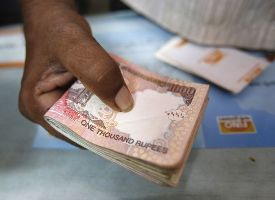 | « Back to article | Print this article |
The recommendations are in line with a fiscal road map, laid by Finance Minister Arun Jaitley's predecessor P Chidambaram
 Just ahead of the Budget, the 14th Finance Commission on Tuesday recommended the Centre to maintain its fiscal deficit at 3.6 per cent of the country's gross domestic product for 2015-16 from 4.1 per cent projected for the current financial year and then maintain it at three per cent for the following four years.
Just ahead of the Budget, the 14th Finance Commission on Tuesday recommended the Centre to maintain its fiscal deficit at 3.6 per cent of the country's gross domestic product for 2015-16 from 4.1 per cent projected for the current financial year and then maintain it at three per cent for the following four years.
The recommendations are in line with a fiscal road map, laid by Finance Minister Arun Jaitley's predecessor P Chidambaram, though the existing time-frame ends at 2016-17.
The Commission's recommendations extended it to 2019-20.
“We consider the existing ceiling on the fiscal deficit of the Union Government at three per cent of GDP appropriate, but it may be able to achieve this by the end of 2016-17,” the Commission said in its report tabled in Parliament.
The Commission recommended that the Centre reduce its revenue deficit from from 2.9 pc in FY'15 to 2.56 pc in FY'16 and then progressively reduce it to 0.93 pc by 2019-20.
However, it also said that it is also feasible for the union government to completely eliminate the revenue deficit earlier than 2019-20, on the back of an improvement in the macroeconomic environment and the revival of growth as well as tax reforms such as the Goods and Services Tax.
The 13th Finance Commission headed by Vijay Kelkar had advised the Centre to bring down its fiscal deficit from 6.8 per cent of the GDP in 2009-10 to three per cent by 2014-15, a task that is all set to be not met.
In fact, the three per cent target for fiscal deficit remained elusive for the successive governments.
The Fiscal Responsibility and Budget Management Act had initially targeted it to be met by 2007-08.
But, it was deferred by a year to 2008-09.
The global financial crisis of that year and the resultant stimulus package widened the deficit to around six per cent then.
Budget 2015: Complete Coverage
Again, it was relaxed in 2012 due to the economic crisis of 2009-10.
Under the amended FRBM Act of 2012, the Centre fixed a revised roadmap of achieving a revenue deficit target of not more than two per cent of the GDP by March 31, 2015 and a fiscal deficit target of three per cent by 2017.
Revenue deficit was to be initially eliminated by 2008-09.
However, sensing that it is difficult to meet the target the then finance minister devised the concept of effective revenue deficit in 2011-12 Budget, which is revenue deficit excluding capital expenditure in revenue transfers to states.
Instead of revenue deficit, effective revenue deficit is being targeted to be eliminated by the next financial year.
The Commission wanted the Centre to do away with the idea of effective revenue deficit.
Even for 2014-15, the Centre will find it extremely difficult to adhere to a fiscal deficit target of 4.1 of the GDP pegged in the Union Budget owing to low indirect tax collection and due to divestment targets not being met.
It will have to have fiscal surplus in the last three months to achieve the target.
However, Jaitley had exuded optimism to meet the target and adhere to fiscal roadmap laid by Chidambaram.
The fiscal consolidation path that the 13th Finance Commission had wanted for the Centre evisaged that the debt-GDP ratio come down from 54.2 per cent in 2009-10 to 44.8 per cent of the GDP by 2014-15.
However, the 14th Commission considered the debt-GDP ratio of 45 per cent as an appropriate ceiling to start with in 2014-15 and hoped it will remain below the level in the coming years because of the expected decline in fiscal deficit.
For the states, the 14th Commission pegged a stiffer fiscal deficit roadmap of 2.74 per cent of their consolidated GDP by the end of 2019-20. The annual limit for states was fixed at three per cent of the GDP.
That apart, it also gave the states a flexibility of 0.25 per cent over and above their annual limit provided their debt-gross state domestic product (GSDP), ratio was less than or equal to 25 per cent in the preceding year.
“In respect of states, we have adopted the fiscal deficit threshold limit of 3 per cent of GSDP as fixed by the 13th Commission.
"We have treated the aggregate debt-GDP ratio of states and its equivalent to GSDP, as determined by the 13th Commission, at 25.9 per cent at the end of 2014-15 as a ceiling for all states in aggregate at end of 2019-20,” the report said.
“Further, we are providing a year-to-year flexibility for additional borrowing to states.
"If the fiscal deficit of a state in a year falls short of the normal yearly limit of three per cent of GSDP that states can borrow to the extent of the shortfall in the given year,” it added.
The 13th Commission had advised a reduction in the fiscal deficit of states from 2.8 per cent in 2009-10 to 2.4 per cent in 2014-15.
The consolidated fiscal deficit target of the Centre and state governments is pegged at 5.74 per cent of their GDP in 2019-20, down from 6.36 per cent in 2015-16.
The Commission also recommended a consolidated sinking fund.
The finance ministry is examining fiscal roadmap suggested by the 14th finance commission and will take a call on the issue in 'due course'.